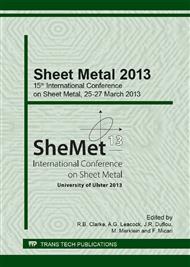p.223
p.231
p.239
p.247
p.255
p.262
p.270
p.277
p.284
Economic Drive Concept for Flexible Forming Presses
Abstract:
A servo-driven eccentric press is a synonym for innovative and economic metal forming technology. The path-time-characteristic of the ram of servopresses can be adapted to individual requirements of various forming processes. To achieve a high dynamic, the rotary inertia of the drive train should be as low as possible. Thus, a flywheel is not suitable to provide the energy required for both, the forming process as well as the ram kinematic. Hence the eccentric shaft is driven by the electric motor only. As a consequence, the press force has to be provided completely via the torque of the servomotor. High investment costs resulting from the required size of the drive components is a challenge to be conquered. This pushes the costs for the drive components. Another challenge is the unbalanced power consumption of the servomotor. Energy-converting and energy-storing systems are essential to compensate the power peaks resulting from the forming process and inertia forces. Nevertheless, these systems are expensive and reduce the energy efficiency of the press. Facing these challenges, a novel and innovative drive concept for eccentric presses is being developed at the Institute of Forming Technology and Machines (IFUM). The concept and the results of a first multibody simulation are presented in this paper.
Info:
Periodical:
Pages:
255-261
Citation:
Online since:
April 2013
Authors:
Keywords:
Price:
Сopyright:
© 2013 Trans Tech Publications Ltd. All Rights Reserved
Share:
Citation:


